
Zha Jiang Mian (老北京炸酱面)
November 13, 2021 Print
As someone who grew up in Beijng, Zha Jiang Mian (炸酱面), or Fried Sauce Noodles (literal translation), definitely has a special place in my heart. My grandparents seemed to always have some Zha Jiang (fried sauce) handy and could whip out a bowl of zha jiang mian in no time. They would add all sorts of toppings to go with the noodles. The toppings were not just limited to raw or blanched vegetables, but included stir-fried veggies. Often times, they would also use ground pork instead of pork belly since it was much easier to get back then. The super flavorful and fragrant zha jiang (fried sauce) mixed with white noodles and various toppings was always a hit no matter the time of year.
The Beijing Style Zha Jiang Mian (炸酱面) typically uses both sweet bean sauce (甜面酱) and soy bean paste (黄酱)2 as the base sauce. The combined base sauce needs to be first cooked with pork belly cubes at a relatively high temperature. Then the sauce needs to be simmered for at least half an hour to result in the full-body flavor that comes from both the base sauce and the pork belly meat. The sauce is considered ready when you can clearly see a layer of fat floating on top. There is actually a saying among Beijingnese, that for Zha Jiang (fried sauce) to be done right, the oil needs to “hug” the sauce. You might get a bit scared to see the layer of oil at first, but it actually doesn’t taste greasy at all. Besides, you have all the toppings to help “neutralize” the oil and add a refreshing feel to the noodles.
The fact is pretty much every household in Beijing and many other parts of China has its own version of zha jiang mian. Some use different base sauces, some add spices and herbs, some are sweeter, some are more savory. But no matter what, it’s always a welcoming dish. Zha Jiang Mian had also spread to other parts of Asia, such as Korea and Japan and evolved further according to local tastes. So don’t feel restricted in that you have to have a certain ingredient. The toppings are especially flexible. I usually use whatever veggies I have in my fridge for toppings.
My oldest son, who is now 5, particularly loves my Zha Jiang Mian. I don’t cook this dish as often as he would like. Although Zha Jiang Mian is super yummy, it does contain quite a high amount of sodium. So I usually reserve it for special occasions, like his birthday (as longevity noodles) or other holidays at my son’s request.
Due to my lower tolerance to carbs these days, I can’t just eat white noodles like I used to—unless I want become diabetic in a few years. So I have been using pastas (such as linguine or fettuccine) instead. Yes, they are not as good as white noodles, but they are still pretty decent. Using these substitutes allows me to still enjoy Zha Jiang Mian. I do add more than the usual amount of toppings for myself to help slow down the speed of sugar absorption to my blood. And I also take a 20 to 30 minute brisk walk every day.
If you like one-bowl noodle dishes, check out my Da Lu Mian (打卤面). It’s another type of noodle dish that I grew up with.
Preparation Time: 15 minutes
Total Time: 1 hour
Servings: 4 – 6 bowls
Ingredients:
Main Ingredients
- 1 lb pork belly1
- 1 1-inch long piece of ginger
- 4 green onions
- 2 star anise
- 1/4 cup sweet bean sauce (甜面酱) 2
- 2 tablespoons soy bean paste (黄酱) + 3 tablespoons water 2
- 1 tablespoon vegetable oil
- ~1 cup of hot water
- bunch of fresh-cut white noodles 3
Toppings3
- 1 medium or half of a large cucumber
- 1 medium radish (such as daikon or watermelon radish)
- 1 medium zucchini

Preparation:
- Separate the fat and lean parts of the pork belly and cut them into small cubes.


- Peel and mince the ginger. Separate the green onions into white and green parts. Cut each part into small pieces. Set aside.

- In a bowl, mix the 2 tablespoons of soy bean paste (黄酱) with 2 tablespoons of water. Then mix in the 1/4 cup of sweet bean sauce.

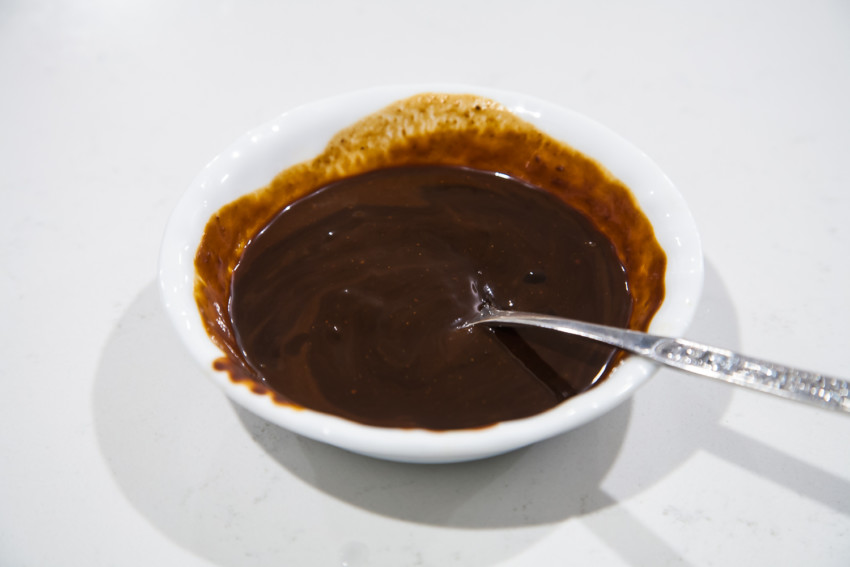
- Heat a wok or fry pan under medium-high heat. Add 1 tablespoon vegetable oil. When oil is getting warm, add the fatty pork belly cubes, stirring often until oil comes out of the fat cubes. Then add the lean pork belly cubes, minced ginger, white part of the green onions, and the 2 star anise, stirring to combine.




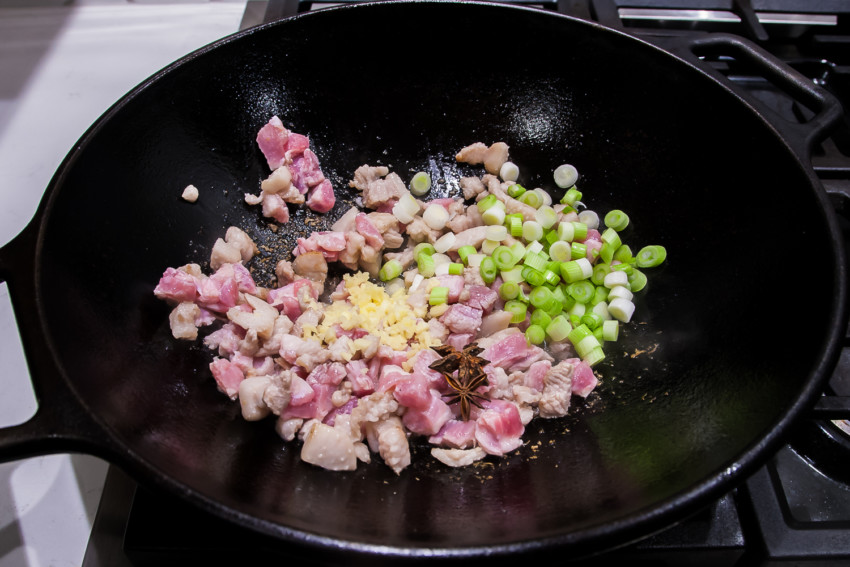

- When the pork belly meat has turned from pink to mostly white, add 1/3 to 1/2 of the the mixed sauce from step 3. Toss and stir often until the sauce is bubbling but is not jumping around. (Adding all the sauce all at once results in lowering the heat too much and can cause the sauce to be boiled rather than fried). Repeat the same procedure one or two more times to fry all the sauce with the pork belly.





- Add the 1 cup of hot water in 2 to 3 separate portions. Stir constantly to ensure the sauce is always bubbling but not burned. Lower the heat and cover the lid to let the zha jiang (炸酱 or fried sauce) simmer for 30 minutes to an hour. Check often to make sure the sauce is not too dry. When the liquid has reduced in volume by approximately half, and the pork belly cubes have a dark reddish glossy color, turn off the heat. Add the green parts of the green onions. Pour the zha jiang to a large bowl.

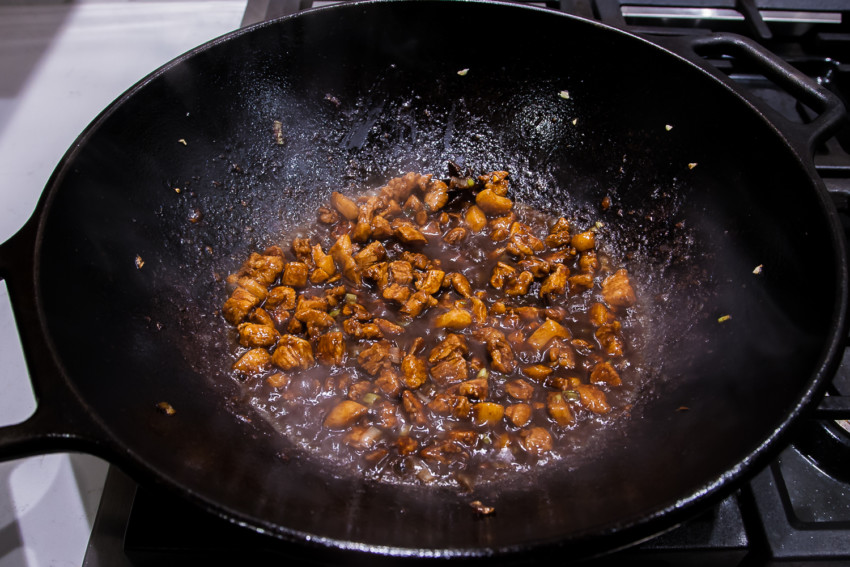






- While zha jiang is being simmered, prepare the toppings and noodles. Julienne the cucumber, radish, and zucchini. Put each into separate plates. Heat a large pot of water. When the water boils, add the freshly made white noodles. Cook according to the instructions on the noodle package. When the noodles are cooked, take the noodles out and rinse in cold water briefly to stop the cooking process. Transfer the noodles into large and deep bowls.




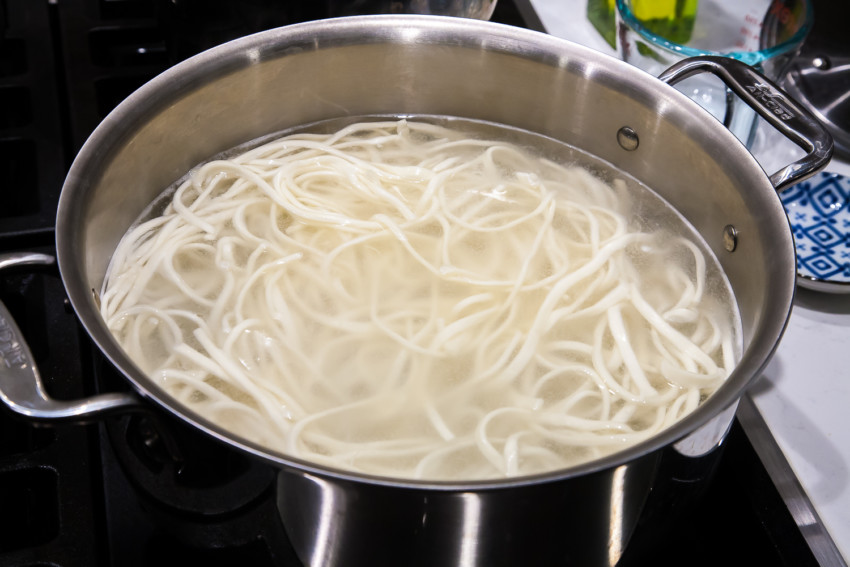
- Take a bowl of white noodles, add a few spoons of zha jiang sauce and various toppings. Mix well and Enjoy!


Bon Appétit
Notes:
- Pork belly is the best option for making Zha Jiang Mian. But you can also use ground pork instead. If using ground pork, it’s best to add some fatty ground pork so the meat is not too lean.
- You can find sweet bean sauce (甜面酱) (the bottle below) in pretty much any Asian grocery store. It comes in various brands and packages such as bottles, cans, and bags. They are all quite similar in taste. The soy bean paste (黄酱) (the red bag below) could be a bit hard to find. It’s a specialty sauce that is normally confined to northern China. It usually comes in a bag with hard paste inside and needs to be first mixed with water before use. If you can’t find soy bean paste (黄酱), you can use 2 tablespoons of soy bean sauce (黄豆酱) instead. Unlike soy bean paste (黄酱), soy bean sauce (黄豆酱) has whole soy beans in it, but the two do share a similar taste. Soy bean sauce is much easier to find. Some popular brands include Haday (海天) and Lee Kum Lee (李錦記).

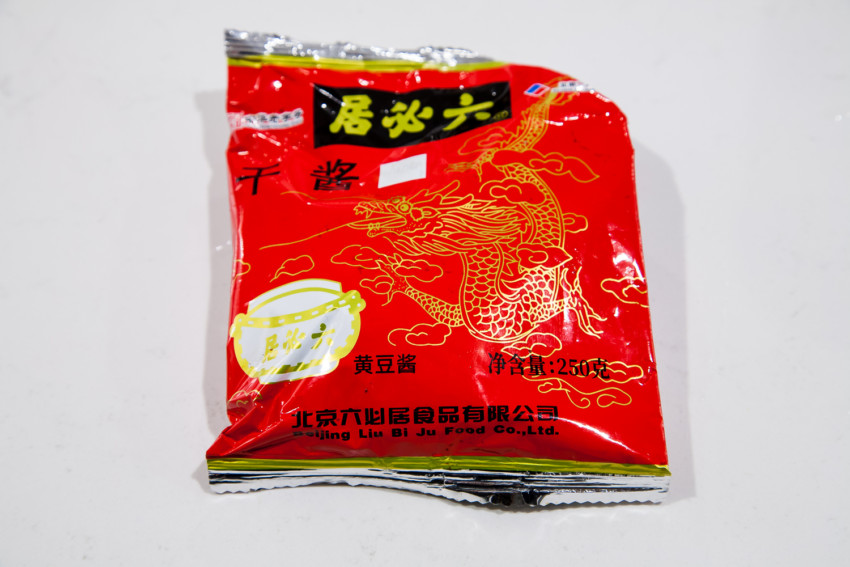
- Toppings for Zhajiangmian are quite flexible. Usually cucumber is a must have. Some people also like to use the white part of northeast green onions (大葱). But the other toppings can be pretty much anything based on personal preference. To name a few, you can use bean sprouts, baked tofu, edamame, carrots, and bell peppers.
- Flat fresh white noodles are preferred. They can be found in most Asian grocery stores. You can also use pasta instead (fettuccine or linguine) like me due to my low tolerance to refined carbs.
As an Amazon Associate I earn from qualifying purchases.







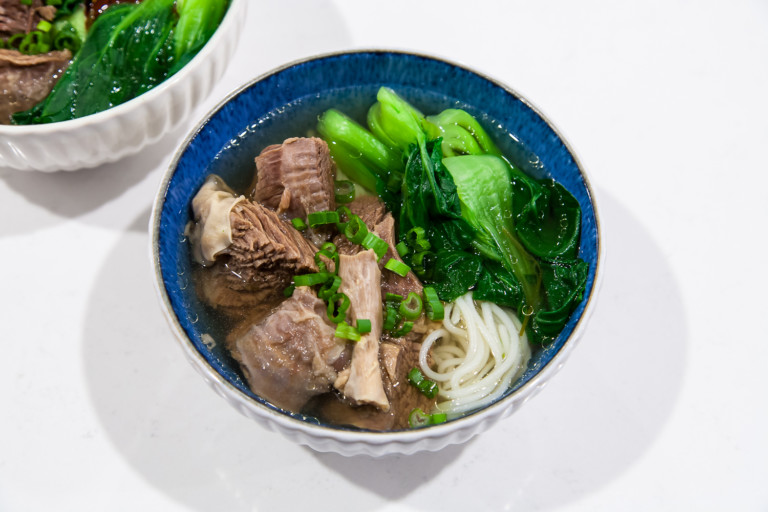











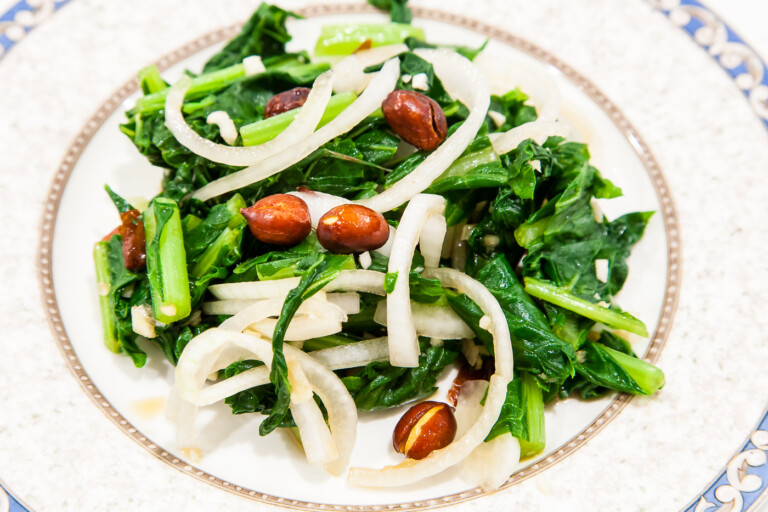


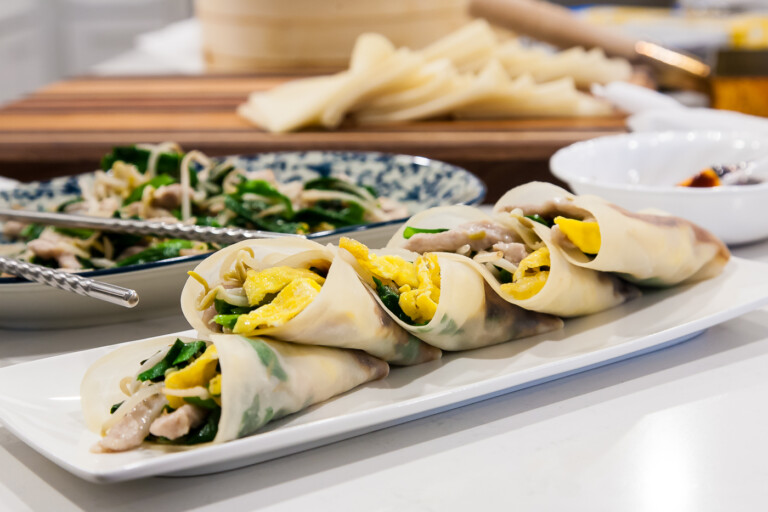



kevin wrote:
Questions about ingredients:
(1) Are 磨原豉 (‘ground bean sauce’) and 黄豆酱 (‘yellow soybean paste’) different sauces? (2) If different, how are they different? (3) Would using 磨原豉 in your zha jiang mian (炸酱面) recipe be a strange taste?
The reason I ask is because I saw another blog recipe (https://thewoksoflife.com/beijing-fried-sauce-noodles-zha-jiang-mian/) in which they use 磨原豉 instead of 黄豆酱. And, on the page describing the sauce (https://thewoksoflife.com/ground-bean-sauce/), they left a comment that 黄豆酱 is pretty much the same as 磨原豉 with the difference being mostly a brand name difference. So, I just was curious about your opinion since I know China is complex with many different food cultures. And, as you may have realized, there are some many different types of bean pastes/sauces found in a well-stocked Asian market in the US and they are translated into English in a rather inconsistent way. So, it’s confusing….
As far as this recipe goes, my kids liked it although I only had 磨原豉 in my pantry so I used that instead (sorry!). (I also have regular 豆瓣酱 – not the spicy kind – but I thought that 豆瓣酱 would be an even more different bean taste.) Personally, I like a different style food that is more ‘sharp’ (like with chili, etc.). But, I did want to make this since it seems to be the inspiration for the Korean dish jjajangmyeon, which my kids like. After making it (with the 磨原豉), the sauce does taste distinct from the Korean sauce. I guess either the beans are different or fermented differently (or both)?
AsianCookingMom wrote:
Hi Kevin, to answer your question.
(1) Yes. 磨原豉 (ground bean sauce) and 黄豆酱 (yellow soybean sauce) are different sauces.
(2) 磨原豉 (ground bean sauce) is a Cantonese sauce, mostly used for marinating, braising, or even stirfry. I would say it tastes sweeter than yellow soybean sauce.
(3) I wouldn’t say strange. It would just be different, especially if you only use 磨原豉 (ground bean sauce) instead of a combination of 甜面酱 (sweet bean sauce) + 磨原豉 (ground bean sauce). The Korean jjajangmyeon has similar taste to the Chinese one, but less salty and sweeter. The vegetables in Korean jjajangmyeon are also cooked together with the sauce whereas in the Chinese Zha Jiang Mian, vegetables are added as toppings at the very end.
The sauce used in the Korean jjajangmyeon is similar to the sweet bean sauce used in Chinese Zha Jiang Mian where wheat flour is the main ingredient. I think that’s probably why you find the taste to be different. The 磨原豉 (ground bean sauce) is made with mostly soybeans. Different methods are also used to make these sauces.
kevin wrote:
Thanks for the reply. And, I should also give you a bigger Thank You! for making this blog so everybody can study more about Chinese cuisines.
Yes, I think that other blog has family members who are from other areas and so have a southern China food bias. Anyway, it’s good know a different Beijing perspective. (“百花齊放”) I’ll have to look for 黄豆酱 next I go to the market. I like to know the ‘authentic’ way to make dishes before I do some modifications. Kind of like knowing the ‘rules’ before you break the rules.
kevin wrote:
Oh. I’ll add some more color: I watched a cooking video on YouTube on this recipe. And, they had an interesting comment about wine. They said that we can use 花雕酒 (huadiao wine) to thin out the bean paste. But, they don’t recommend using regular Chinese cooking wine (like 紹興酒 shaoxing wine, I guess?) since it has such a different taste (which is what I would be tempted to do, haha). If we don’t have 花雕酒, then we should simply just use water. This makes me very curious to taste & smell what 花雕酒 is like compared to other wines. Well, I don’t know if we can even find this wine in the US. Anyway, I thought this was an interesting detail (from the restaurant perspective, I suppose).
AsianCookingMom wrote:
Thanks Kevin, that’s quite interesting! I never thought about using 花雕酒 (Huadiao wine) to thin out the bean paste, but I’m definitely gonna try that next time. 花雕酒 (Huadiao wine) is actually a high quality yellow wine, just like Shaoxing wine, which is also a type of yellow wine. You can probably get one from your local Asian grocery store.